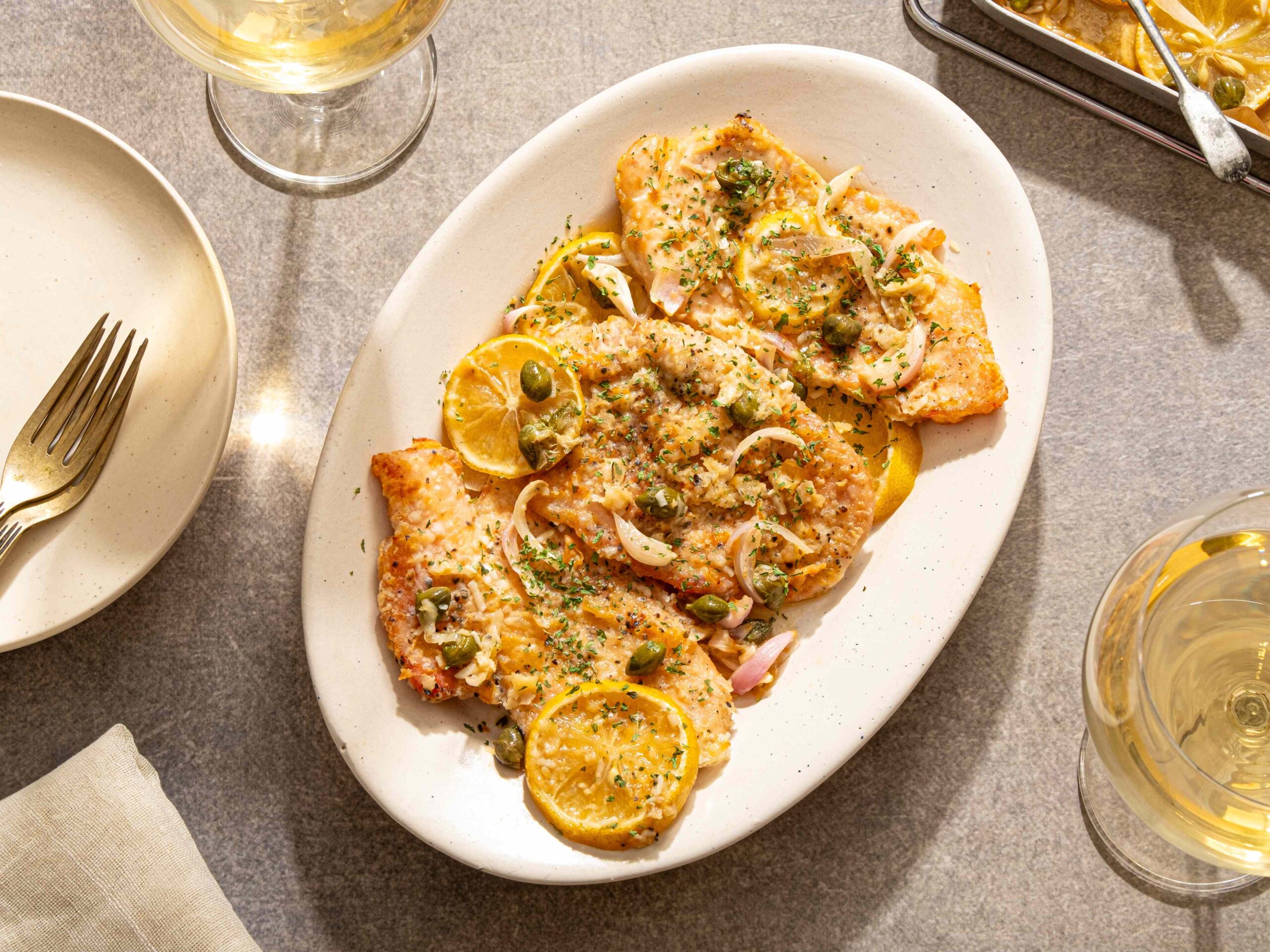:max_bytes(150000):strip_icc():format(jpeg)/2025080420250722-SEA-SheetPanChickenPiccata-JatinSharma-HERO-15938f2f8c3341dca01cc9ac5ffb8645.jpg)
Why It Works
- Halving and pounding boneless, skinless chicken breasts helps the meat cook quickly and evenly.
- Preheating the sheet pan and cooking oil helps the chicken brown effectively.
Chicken piccata, a beloved Italian American dish of fried breaded chicken in a zesty sauce of lemon juice and capers, is a favorite dinner for many. As delicious as classic chicken piccata is, searing or frying chicken in hot oil can leave behind a messy, greasy stovetop—hardly ideal for weeknight cooking. That’s where this sheet-pan version comes in.
Like classic chicken piccata, it’s juicy and saucy, with chicken cutlets nestled in a buttery sauce with sliced lemons and shallots. Everything, including the sauce, comes together right on the sheet pan in a few simple steps. I arrange sliced lemons and shallots all around the chicken, and once the chicken is cooked, I remove it, let the aromatics continue cooking, and deglaze the sheet pan with a mixture of capers, white wine, and water. Some butter and grated garlic go in next, and once the sauce thickens, dinner is ready to serve. And because all the cooking happens in the oven, there’s no need to worry about hot oil spattering across the stovetop.
Here are a few tips for making it.
For Tender, Quick-Cooking Chicken, Halve and Pound Your Cutlets
Boneless, skinless chicken breast notoriously turns dry and chalky if overcooked. To avoid this, it’s crucial to cook chicken breast well and with care. To ensure even cooking, I slice a large chicken breast in half horizontally to create two cutlets, then pound them to about a quarter-inch thickness. I find it helpful to place the chicken in the freezer for about 15 minutes first, which firms the flesh slightly and makes slicing easier.
Halving and pounding the chicken offers two key benefits: It helps the cutlets cook more quickly than a whole breast and reduces the risk of overcooking the thinner part before the thicker part is done. Pounding also tenderizes the meat, as former Serious Eats editor Kenji notes in his article about reasons to pound chicken breasts. Applying repeated pressure separates and relaxes muscle fibers, making the meat less tough. (No meat pounder? A small, heavy pan—such as cast iron or carbon steel skillet—or a rolling pin works well too.)
Make the Sheet Pan Work Like a Skillet by Preheating It in the Oven
Classic piccata starts with sautéed or shallow-fried cutlets. In this recipe, I mimic that process by preheating a sheet pan in the oven, briefly removing it to coat it with neutral oil, then returning it to the oven. When the cutlets hit the hot oil in the preheated pan, they sizzle and lightly sear, much like they would in a skillet.
To Bread or Not to Bread the Chicken?
Some versions of classic chicken piccata call for coating the chicken in both egg and a cheesy breadcrumb mixture, à la chicken Milanese, to give it a satisfyingly crispy crust. Other cooks skip the eggs and breadcrumbs and simply coat the cutlets in some flour, a simpler route that minimizes mess but still makes for a delicious chicken dinner. That’s the route I opt for here for weeknight ease and simplicity.
For a Sauce With Body, Finish With Butter
Once the chicken is cooked, you’ll build a pan sauce in the sheet pan. Add capers, a splash of white wine, and water, then slide it back into the oven for five minutes. The liquid deglazes the pan and loosens any caramelized bits, while further softening the sliced lemon and shallots. Once it’s out of the oven, you’ll finish the sauce by stirring in cubes of butter. This technique, called “monté au beurre” (mounting with butter) in French cuisine, involves adding butter at the end of cooking so it melts gradually, thickening and emulsifying the sauce for a rich, silky finish.
A scattering of fresh parsley over the finished dish is an optional but nice touch. Serve the chicken with your favorite vegetable sides, such as steamed broccoli, asparagus, or green beans, and plenty of crusty bread for soaking up the tangy, buttery sauce.
This Sheet-Pan Chicken Piccata Is So Good, You’ll Forget It’s a Weeknight
Cook Mode
(Keep screen awake)
-
2 large boneless, skinless chicken breasts (1 1/2 pounds; 680 g total), halved horizontally to create 4 pieces (see notes)
-
1/4 cup all-purpose flour (about 1 1/4 ounces; 32 g)
-
1 1/2 teaspoons Diamond Crystal kosher salt; for table salt, use half as much by volume
-
1/2 teaspoon freshly ground black pepper
-
1/3 cup (80 ml) neutral oilsuch as canola or vegetable
-
1 medium lemonthinly sliced cross-wise, seeds removed
-
2 large shallots (about 3 1/2 ounces; 100 g each), cut cross-wise into 1/4-inch slices
-
2 tablespoons drained capers (about 3/4 ounces; 20 g)
-
1/3 cup (80 ml) dry white wine or low-sodium chicken broth
-
3 tablespoons (45 ml) water
-
2 tablespoons unsalted butter (1 ounce; 28 g), cut into 1/2-inch cubes
-
1 medium clove garlicfinely grated or minced
-
Chopped fresh parsleyfor serving (optional)
-
Crusty breadfor serving
-
Adjust oven rack to middle position. Set an empty 13-by-18-inch rimmed baking sheet on rack and preheat oven to 425°F (220°C).
Serious Eats / Jatin Sharma
-
Place one halved chicken breast on a clean cutting board and, using a meat tenderizer, gently pound chicken to about 1/4-inch thickness. (Alternatively, place a large sheet of parchment over your cutting board. Set chicken breast on one side of parchment paper and fold paper in half over chicken. Use a small heavy skillet, rolling pin, or meat tenderizer to gently pound chicken to about 1/4-inch thickness.) Transfer chicken to a large plate; set aside. Repeat with remaining chicken breast halves. Season chicken cutlets all over with salt and pepper
Serious Eats / Jatin Sharma
-
Using kitchen towels or oven mitts, carefully remove sheet pan from oven. Pour oil onto onto hot sheet pan and return to oven; heat oil until it is hot and shimmering, about 10 minutes.
Serious Eats / Jatin Sharma
-
Add flour to a wide, shallow bowl. Working with one cutlet at a time, dredge chicken in flour, shaking off excess. Set cutlet aside in bowl and repeat dredging with remaining chicken.
Serious Eats / Jatin Sharma
-
Using kitchen towels or oven mitts, carefully remove sheet pan from oven. Place dredged chicken cutlets on pan of hot oil (they should sizzle slightly when hitting the hot oil) and bake until bottoms are lightly brown, about 10 minutes.
Serious Eats / Jatin Sharma
-
Carefully remove pan from oven and, using tongs, flip chicken, placing cutlets in the center of sheet pan and arrange sliced lemons and shallots all around. Bake until chicken is cooked through and registers 165°F (74°C) on an instant-read thermometer, 7 to 10 minutes.
Serious Eats / Jatin Sharma
-
Using tongs, remove chicken to a clean plate, leaving lemon slices and shallots behind. Add wine, water, and capers to the baking sheet. Return baking sheet to the oven and bake until flavors meld and lemons have softened slightly, about 5 minutes. Remove from oven, and immediately stir in butter and grated garlic, using a metal spatula, such as a fish spatula, to stir and scrape up any browned bits on the pan. Stir until butter has melted and sauce has thickened slightly, about 3 minutes. Season to taste with salt and pepper. Ladle sauce over chicken, top with parsley, if using, and serve with bread.
Serious Eats / Jatin Sharma
Special Equipment
13- by-18-inch rimmed baking sheet, meat tenderizer, tongs, instant-read thermometer, metal spatula, such as a fish spatula
Notes
Some grocery stores sell pre-sliced chicken breasts; look for boneless split chicken breasts. A butcher may be able to cut and even pound the chicken for you.
Place the chicken breasts in the freezer for 15 minutes to help the meat firm up slightly before halving.
To double the recipe, use two rimmed baking sheets at once, with racks positioned on the upper and lower third of the oven. Rotate and swap pan positions halfway through cooking.
Make-Ahead and Storage
Leftovers can be refrigerated in an airtight container for up to 3 days. Reheat in the microwave until warmed through.

